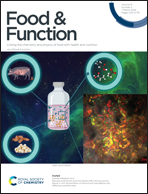Fried food consumption, genetic risk, and incident obesity: a prospective study†
Abstract
Background and aims: Genetic and dietary factors contribute to adiposity risk, but little evidence supports genetic personalization of fried food intake recommendations for the management of obesity. This study aimed to assess the associations between fried food consumption and adiposity incidence and whether the associations were modified by an individual's genotype. Methods: We included 27 427 participants who had dietary data assessed by a validated 24 h dietary recall and available anthropometric information from the UK Biobank study. The genetic risk score (GRS) was calculated using 940 BMI associated variants. Results: With an average of 8.1 years of follow-up, 1472 and 2893 participants were defined as having overall obesity and abdominal obesity, respectively. Individuals in the highest categories of fried food consumption were positively associated with the risk of obesity (HR = 1.31; 95% CI 1.10–1.56) and abdominal obesity (HR = 1.27; 95% CI 1.12–1.45) compared with the lowest categories. Moreover, fried food consumption had a significant interatction with obesity GRS for abdominal obesity risk (P interaction = 0.016). Fried food intake was associated with a higher abdominal obesity risk (HR = 1.59, 95% CI: 1.25–2.00) among participants with a lower genetic risk. Conclusions: Our findings indicated that fried food consumption had a higher abdominal obesity risk among individuals with a lower genetic risk, suggesting the restriction of fried food intake for this group of people.



 Please wait while we load your content...
Please wait while we load your content...